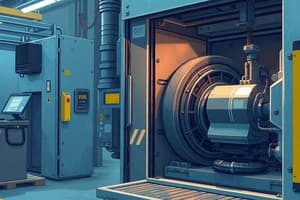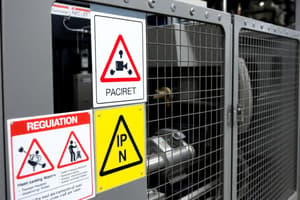Podcast
Questions and Answers
What is the primary role of electricians in controlling electrical accidents?
What is the primary role of electricians in controlling electrical accidents?
- Implementing safety standards and regulations (correct)
- Ensuring compliance with extravagant safety measures
- Regularly test lighting installations for efficiency
- Upgrading electrical systems without oversight
Which element is essential for good illumination in an industrial setting?
Which element is essential for good illumination in an industrial setting?
- Following recommended minimum standards of illumination (correct)
- Using a single light source for all areas
- Ignoring the color temperature of lighting
- Selecting lighting based solely on aesthetic appeal
What is the purpose of ventilation in an industrial context?
What is the purpose of ventilation in an industrial context?
- To minimize the use of mechanical ventilation systems
- To ignore the physiological effects of heat regulation
- To regulate thermal comfort and heat control (correct)
- To maintain a stagnant environment for air quality
What does the concept of 5S intend to improve in a workplace?
What does the concept of 5S intend to improve in a workplace?
Which type of ventilation is focused on emissions from specific processes?
Which type of ventilation is focused on emissions from specific processes?
What is the primary purpose of machine guarding?
What is the primary purpose of machine guarding?
Which of the following is a common hazard associated with manual handling of materials?
Which of the following is a common hazard associated with manual handling of materials?
What safety feature is essential in the design and construction of lifting machinery?
What safety feature is essential in the design and construction of lifting machinery?
What should be considered when selecting hand tools for safety?
What should be considered when selecting hand tools for safety?
What is one way to avoid excessive muscular effort when lifting?
What is one way to avoid excessive muscular effort when lifting?
Which tool feature is essential for avoiding tool accidents?
Which tool feature is essential for avoiding tool accidents?
What is a critical safety aspect to consider when using electrical equipment?
What is a critical safety aspect to consider when using electrical equipment?
Which type of lifting tackle is commonly used for safe lifting?
Which type of lifting tackle is commonly used for safe lifting?
Flashcards
Machine Guarding
Machine Guarding
Protecting workers from hazardous machinery parts by using physical barriers or safety devices.
Types of Guards
Types of Guards
Different types of guards include fixed, adjustable, interlocked, and movable guards, each tailored to specific hazards.
Safe Lifting Techniques
Safe Lifting Techniques
Proper lifting techniques minimize strain on the body, involving bending knees, keeping back straight, and using leg muscles.
Maximum Load
Maximum Load
Signup and view all the flashcards
Lifting Machinery Safety
Lifting Machinery Safety
Signup and view all the flashcards
Tool Accident Prevention
Tool Accident Prevention
Signup and view all the flashcards
Electrical Safety
Electrical Safety
Signup and view all the flashcards
Portable Electrical Apparatus
Portable Electrical Apparatus
Signup and view all the flashcards
Static Electricity Hazards
Static Electricity Hazards
Signup and view all the flashcards
Electrician's Role in Safety
Electrician's Role in Safety
Signup and view all the flashcards
Good Illumination Benefits
Good Illumination Benefits
Signup and view all the flashcards
Housekeeping 5S
Housekeeping 5S
Signup and view all the flashcards
Confined Space Permit
Confined Space Permit
Signup and view all the flashcards
Study Notes
Machine Guarding
- Statutory Provisions: Principles of machine guarding are legally mandated.
- Types of Guards: Various types of guards exist, their design and selection are critical. Specific types of machinery (woodworking, paper, rubber, printing) require specific precautions.
- Built-in Safety Devices: Essential safety features integrated into machines.
- Guard Maintenance: Guards need regular maintenance and repair to ensure functionality and safety.
- Incidental Safety Devices: Additional safety tools and equipment.
- Workplace/Plant Design: Safe design principles for workplaces are crucial.
Manual Handling and Storage
- Manual Handling Hazards: Specific risks associated with manually lifting and moving objects.
- Avoiding Excessive Effort: Techniques and methods for reducing strain during manual handling.
- Kinetic Lifting Methods: Correct procedures for lifting and handling materials for reduced risk of injury.
- Maximum Loads: Safe load limits for manual handling.
- Object Handling: Safe practices for different object sizes, shapes and weights.
- Handling Accessories: Safe use of equipment for handling materials.
- Material Storage: Proper storage techniques to avoid accidents and hazards.
Mechanical Handling
- Lifting Machinery: (cranes, elevators, conveyors, dumpers, pay loaders) and their safety aspects during design, construction, and testing.
- Operator Training: Essential operator training in safe operation, signaling, inspection, and maintenance.
- Power Trucks/Tractors: Safety features related to design, construction, operation, inspection and maintenance.
- Lifting Tackes: Details related to chain slings, rope slings, fibre and wire rings, hooks, shackles, swivels, eye bolts, and safe working load calculations.
Hand Tools & Portable Power Tools
- Tool Accidents: Common causes of accidents related to hand and portable power tools.
- Accident Control: Strategies to minimize tool accidents.
- Centralized Tool Control: Methods for centrally managing tools.
- Tool Supply/Storage: Proper procurement, storage, and distribution of tools.
- Inspection & Maintenance: Regular inspection, maintenance, and repair for tool safety.
- Tool Failure: Common causes leading to tool failure.
- Tool Treatments: Safety considerations in tempering, sharpening, and dressing tools.
- Tool Handles: Importance of safe tool handle design and use.
- Tool Types: Specific types of hand tools (metal cutting, woodworking, miscellaneous cutting, material handling) and portable power tools, along with their selection, inspection, maintenance, and safe use.
Electrical Hazards
- Electrical Dangers: Risks associated with electricity.
- Safety Limits (Voltage/Amperage): Safe operating limits of electricity.
- Safe Distances: Safe distances from electrical lines and equipment.
- Conductor Capacity & Protection: Proper conductor sizing and protection measures.
- Joints and Connections: Proper jointing and connections of electrical equipment.
- Power Cutting-off: Methods for safely cutting off power sources.
- Overload/Short Circuit Protection: Necessary protection measures related to overloaded or shorted circuits.
- Earth Fault Protection: Protection against ground faults in electrical systems.
- Tests: Insulation, continuity and earth fault tests.
- Overvoltage Protection: Safeguarding against harmful overvoltages.
- Portable Electrical Apparatus: Safety precautions for specific portable electrical devices. (flame-proof)
- Electrical Equipment: Safe selection, installation, maintenance and use of electrical equipment.
- Static Electricity Control: Precautions in controlling hazards associated with static electricity.
- Electrician's Role: Electrician's role in controlling electrical accidents.
- Legal Provisions: Relevant Indian Electricity Acts and Rules.
Industrial Lighting
- Lighting Purpose: Importance of good illumination.
- Lighting and Safety: Relationship of lighting to safety
- Lighting and Work Performance: Impact of lighting on work quality and efficiency.
- Artificial Lighting Types: Various types of artificial lighting sources.
- Illumination Principles: Principles of good illumination.
- Recommended Standards: Minimum illumination standards and requirements.
- Lighting Installation Design: Design principles for good lighting installations.
- Maintenance and Color: Maintenance and color considerations in lighting installations.
Pressure Vessels
- Fired/Unfired Vessels: Safety regulations for both types of pressure vessels.
- Statutory Provisions: Regulations regarding pressure vessels.
- Testing Requirements: Different testing requirements for pressure vessels.
- Design and Construction Aspects: Principles and safety considerations during construction.
- Boilers: Specific safety precautions and operation requirements for boilers.
Ventilation and Heat Control
- Ventilation Purpose: Benefits and importance of ventilation.
- Thermal Environment: Measurements and impact of thermal environment on workers.
- Heat Regulation: Human physiology in response to heat.
- Thermal Comfort: Factors influencing worker comfort in hot conditions.
- Indices of Heat Stress: Factors for evaluating heat stress levels.
- Thermal Limits: Limits for acceptable thermal conditions in work settings.
- Ventilation Types: Natural ventilation, mechanical ventilation, air conditioning, process ventilation.
- Heat Control Methods: Control of heat exposure through different methods at the source or through other methods.
Housekeeping
- 5S Concept: Significance of the 5S method in workplace organization.
- Management Responsibility: Management's role in maintaining good housekeeping standards.
- Safety Engineer's Role: Safety engineers' role in promoting good housekeeping.
- Planning & Follow-Up: Importance of planning and follow-up in implementing good housekeeping.
- Cooperation: Importance of overall team collaboration for good housekeeping.
- Workplace Accidents: Common safety hazards caused by poor housekeeping.
- Unsafe Housekeeping Practices: Common examples of unsafe housekeeping.
- Waste Disposal: Safe disposal of scrap and wastes.
- Spill Prevention: Strategies for preventing spills.
- Marking/Color Coding: Importance of using color-coding for identifying safe areas.
- Clean-up Campaigns: Implementing clean-up campaigns.
- Cleaning Methods: Various methods and equipment used in cleaning.
- Employee Assignments: Specific employee assignments for cleaning tasks.
- Inspection & Checklist: Importance and examples of workplace inspections and checklists.
- Results of Good Housekeeping: Benefits of implementing good housekeeping practices.
Special Precautions
- Working at Height: Precautions for working at heights.
- Confined Spaces: Precautions when working in confined spaces.
- Work Permits: Importance of work permits for work at height and in confined spaces.
Laws and Regulations
- Relevant Acts: Specific sections from Factories Act, Indian Electricity Act, Explosive Act, and Gas Cylinder Rules.
Studying That Suits You
Use AI to generate personalized quizzes and flashcards to suit your learning preferences.
Description
This quiz covers crucial principles of workplace safety focusing on machine guarding and manual handling techniques. Explore statutory provisions, various guards, built-in safety devices, and appropriate lifting methods to ensure a safe working environment. Assess your understanding of safety best practices related to machinery and manual tasks.




